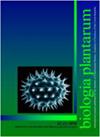Lysigenous aerenchyma formation: responsiveness to waterlogging in oil palm roots
IF 0.9
4区 生物学
Q4 PLANT SCIENCES
引用次数: 2
Abstract
Oil palm (Elaeis guineensis Jacq.) responds to waterlogging stress by induction of lysigenous aerenchyma tissues, which facilitates the flow of oxygen through their root tissues for survival under waterlogged conditions. Thus, the morphological and genetic adaptation involved in lysigenous aerenchyma formation in the roots of the oil palm genotype Deli × Calabar under waterlogging stress was evaluated. This study found the highest number of dead cells after waterlogging stress for 2 d in the secondary root, while the percentage of root porosity was increased with increasing of time in both roots, especially at 1.0 - 2.0 cm from the root tip. This change in cell morphology implied the formation of lysigenous aerenchyma in oil palm roots under waterlogging stress. At the same time, most of the candidate genes involved in lysigenous aerenchyma formation revealed a higher mRNA expression after waterlogging stress for 3 d. Genes of ethylene synthesis group ACS3, ACO, and ACO1 were highly up-regulated in both types of roots, while XTH22, XTH23, and CEL12 in the cell wall modification group were more highly up-regulated in the primary roots than in the secondary roots. CML11, CAMTA4, TCTP, and CPI1 in a signaling group were up-regulated in the primary roots, but they were down-regulated in the secondary roots. NAC29, ERF1, ERF113, and HSFA2C in a transcription factor group were strongly up-regulated in the oil palm roots. However, there have been no previous reports on the expression of CAMTA4, bHLH79, and bHLH94 under waterlogging conditions. Our findings confirm gene expression during lysigenous aerenchyma development in oil palm roots under waterlogging. It can also be stated that primary roots are an important part of the adaptation mechanism of oil palm roots for survival under waterlogging stress. Furthermore, the molecular markers of all expressed genes will be developed and applied in our oil palm breeding project for selection of waterlogging tolerance.油棕根部溶解性通气组织的形成:对涝渍的响应
油棕(Elaeis guineensis Jacq.)通过诱导溶生通气组织来应对淹水胁迫,这有助于氧气通过其根组织流动,以在淹水条件下生存。因此,评价了油棕基因型Deli×Calabar在淹水胁迫下根系溶生通气组织形成的形态和遗传适应。本研究发现,淹水胁迫2 d后,次生根的死细胞数量最多,而根系孔隙率随时间的增加而增加,尤其是在距根尖1.0-2.0 cm处。这种细胞形态的变化暗示了在淹水胁迫下油棕根中溶生通气组织的形成。同时,大多数参与溶生通气组织形成的候选基因在淹水胁迫3天后显示出更高的mRNA表达。乙烯合成组ACS3、ACO和ACO1的基因在两种类型的根中都高度上调,而XTH22、XTH23、,细胞壁修饰组中的CEL12在初生根中比在次生根中更高上调。信号组中的CML11、CAMTA4、TCTP和CPI1在初级根中上调,但在次级根中下调。转录因子组中的NAC29、ERF1、ERF113和HSFA2C在油棕根中强烈上调。然而,以前没有关于CAMTA4、bHLH79和bHLH94在内涝条件下表达的报道。我们的研究结果证实了在淹水条件下油棕根溶生通气组织发育过程中的基因表达。也可以说,初生根是油棕根在淹水胁迫下生存适应机制的重要组成部分。此外,将开发所有表达基因的分子标记,并将其应用于我们的油棕育种项目,以选择耐涝性。
本文章由计算机程序翻译,如有差异,请以英文原文为准。
求助全文
约1分钟内获得全文
求助全文
来源期刊

Biologia Plantarum
生物-植物科学
CiteScore
2.80
自引率
0.00%
发文量
28
审稿时长
3.3 months
期刊介绍:
BIOLOGIA PLANTARUM is an international journal for experimental botany. It publishes original scientific papers and brief communications, reviews on specialized topics, and book reviews in plant physiology, plant biochemistry and biophysics, physiological anatomy, ecophysiology, genetics, molecular biology, cell biology, evolution, and pathophysiology. All papers should contribute substantially to the current level of plant science and combine originality with a potential general interest. The journal focuses on model and crop plants, as well as on under-investigated species.
 求助内容:
求助内容: 应助结果提醒方式:
应助结果提醒方式:


